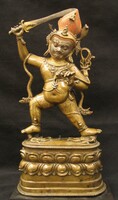Achala According to the Atisha Tradition - Updated

There are two well known traditions for the standing Nila Achala. The more common of the two standing forms is the Achala of the Jowo Atisha Tradition. The second of the forms belongs to the Mitra Yogin Tradition. In the Kadam Tradition of Atisha the Achala is known as one of the 'Four Deities of Kadam' (kadam lha shi). In the Mitra Tradition there are eleven deities in total.
There are several other Tantric deities which can be easily confused with the standing form of Achala such as Krodha Vajrapani, Black Manjushri and Vignantaka. There is also a retinue protector deity named Achala that is part of the group known as the Ten Wrathful Ones.
The top of the head is often adorned with a very small figure of Akshobhya Buddha. Some texts name Vajrasattva as the figure.
Under the feet of Achala is the prostrate form of either a single figure or two figures. According to the Nartang Gyatsa text of Chim Namkha Drag (1210-1285) the single prostrate figure is Vignayakaraja with an elephant head. According to the Rinjung text of Taranata (1575-1634) there are two figures, the Elephant Trunk Ganesha and Maheshvara (Shiva).
"...Arya Achala with a body blue-black in colour, one face and two arms. The right hand holds up to the sky a wisdom sword. The left [performs] a wrathful gesture together with a lasso. [Achala] has three eyes, red and round, orange hair bristling upwards. The limbs are adorned with snake ornaments and jewels, a tiger skin as a lower garment. Within a vast swirling mass of wisdom fire [he] stands with the right leg bent and the left straight atop Vignayakaraja [the king of hindrances]. Vajrasattva adorns the head." (Drub Tab Kun Tu, vol.13, Nartang Gyatsa, pp.861-862. TBRC W19221).
